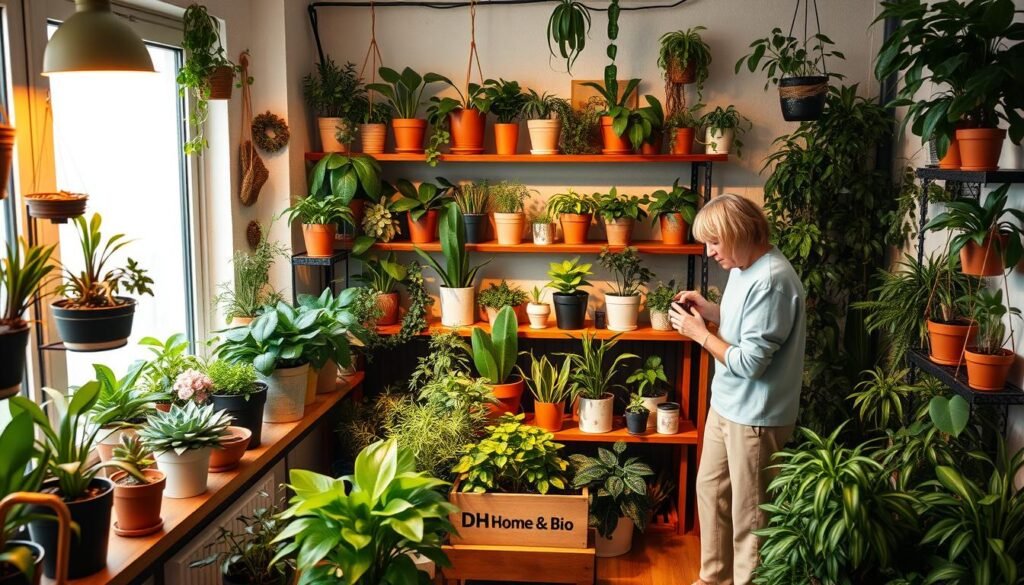
Cultive plantas com Iluminação Artificial.
Sou apaixonada por jardinagem interna e descobri que #iluminaçaoartificialparaplantas muda tudo. É incrível para cultivar plantas domésticas, ervas e vegetais dentro de casa. Lembro-me de quando usei #luzesledsparaplantas pela primeira vez e vi minhas plantas crescerem tão rápido. Era como se estivessem vivas, graças à luz certa.
As plantas precisam de luz, água e nutrientes para crescer bem. Às vezes, os espaços internos não recebem luz solar suficiente. É aí que a iluminação artificial ajuda, criando um local perfeito para as plantas prosperarem. Seja você novo em jardinagem interna ou experiente, aprender sobre #iluminaçãoartificialparaplantas abre novas possibilidades.
Exploraremos a iluminação artificial para plantas, incluindo novas tecnologias e histórias de sucesso. Prepare-se para levar sua jardinagem interna a novos patamares com #iluminaçaoartificialparaplantas .
Principais conclusões
- Descubra os benefícios do uso de iluminação artificial para o crescimento de plantas em ambientes internos e cultivo durante todo o ano.
- Aprenda a criar um ambiente de cultivo personalizado que atenda às necessidades específicas de iluminação das suas plantas.
- Explore as mais recentes tecnologias em iluminação artificial, incluindo opções de LED, fluorescente e descarga de alta intensidade (HID).
- Obtenha insights práticos e histórias de sucesso reais de jardineiros internos experientes.
- Entenda a importância do espectro de luz , duração e intensidade para a saúde e produtividade ideais das plantas.
Compreendendo a iluminação artificial para plantas
Como jardineiro de ambientes internos, saber sobre #iluminaçãointernaparacultivos é essencial para cultivar plantas saudáveis. A iluminação artificial ajuda a imitar a luz solar natural. Isso é crucial para a fotossíntese e o crescimento.
O que é iluminação artificial?
Iluminação artificial é luz artificial usada para ajudar ou substituir a luz solar natural para plantas. Esses sistemas dão às plantas a luz que elas precisam para o crescimento e desenvolvimento.
Importância do espectro de luz para o crescimento
O espectro de luz é vital para o crescimento das plantas e fotossíntese . Diferentes comprimentos de onda de luz afetam as plantas de diferentes maneiras. Por exemplo, a luz vermelha ajuda no crescimento do caule e na floração, enquanto a luz azul auxilia no crescimento das folhas e do compacto.
Growers can choose the right light mix for their plants. This supports plants from seed germination to fruit production. Artificial lighting gives growers control over their plants’ environment.
| Light Wavelength | Effect on Plants |
|---|---|
| Red Light | Promotes stem elongation and flowering |
| Blue Light | Encourages compact growth and leaf development |
| Far-red Light | Influences plant architecture and flowering |
Understanding the light spectrum and its effects on plant growth and photosynthesis is crucial. Indoor gardeners can then create the best lighting for their #iluminaçãointernaparacultivos. This leads to healthier, more vibrant plants.
Types of Artificial Light for Plants
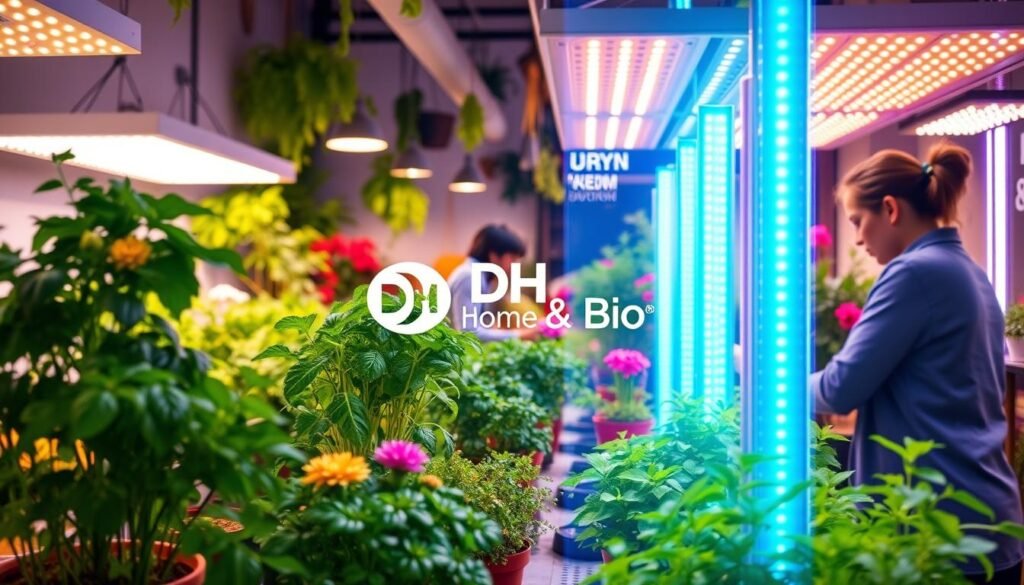
Choosing the right light for your indoor garden is key. You can pick from #lâmpadasdeledparavegetação, fluorescent lights, and HID lights. Each has its own benefits and drawbacks. Let’s look at them to find the best one for you.
LED Grow Lights
LED grow lights are a favorite among indoor gardeners. They use less energy and give plants the light they need. LEDs don’t get hot, so you can put them close to your plants safely. Plus, they last a long time, saving you money in the long run.
Fluorescent Lights
Fluorescent lights have been around for a long time. They give plants a wide range of light and are easy on the wallet. But, they get hotter than LEDs and need to be replaced more often.
High-Intensity Discharge (HID) Lights
HID lights, like metal halide and high-pressure sodium, shine bright and get through thick leaves. They’re great for big indoor gardens or homes with special lighting needs. But, they get very hot, so you need to keep them cool to protect your plants.
When picking artificial light for your plants, think about energy use, heat, and the light spectrum your plants need. Knowing the good and bad of each light will help you choose the best one for your garden.
Benefits of Using #iluminaçaoartificialparaplantas
Using #sistemasdeluzparacrescimentodefrutosehortaliças, or artificial lighting for plants, brings many benefits. It lets you grow plants all year and improve their quality and yield. This is thanks to controlled environments.
One big advantage is growing plants where there’s not enough natural light. This means you can grow many different fruits, veggies, and herbs. Even in cities or places with little sunlight.
Artificial lighting also lets you control the light’s intensity, how long it lasts, and its color. This helps you meet your plants’ needs exactly. Your plants will grow better, be healthier, and taste even better.
Also, #sistemasdeluzparacrescimentodefrutosehortaliças means you can grow plants all year. You can have a garden full of fresh food, no matter the season. This way, you can grow more types of plants all year.
By using #sistemasdeluzparacrescimentodefrutosehortaliças, you can make your indoor or urban garden amazing. It will be full of fresh, tasty food all year.
| Benefit | Description |
|---|---|
| #sistemasdeluzparacrescimentodefrutosehortaliças | Enables year-round growing and controlled environments for enhanced plant yields and quality. |
| Cultivation in Spaces with Limited Sunlight | Allows for growing a diverse array of fruits, vegetables, and herbs in urban settings or areas with insufficient natural light. |
| Precise Control over Light Conditions | Enables tailoring of light intensity, duration, and spectrum to meet the specific needs of your plants, leading to increased yields and improved plant health. |
| Year-Round Growing | Facilitates the ability to maintain a consistent, optimal environment, extending the growing season and diversifying the range of crops you can cultivate. |
Using #sistemasdeluzparacrescimentodefrutosehortaliças can make your indoor or urban garden amazing. It will be full of fresh, tasty food all year.
Choosing the Right Lighting for Your Plants
Creating a thriving indoor garden starts with the right artificial lighting. It’s important to pick lighting that meets your plants’ needs. This includes considering their growth stage and the space available. By knowing your plants’ #fontesdeluzsuplementaresparaplantas, you can give them the right light intensity and spectrum.
Assessing Plant Needs
First, look at what light your plants need. Different plants require different amounts of light. Some need bright, intense light, while others prefer softer, more diffused light. Also, think about how their lighting needs change as they grow.
Evaluating Your Space
Then, examine your grow space. Measure it and figure out the best spot for your lights. This helps you choose the right size and place for your lights. It ensures all your plants get the light they need.
| Plant Species | Light Intensity | Light Duration |
|---|---|---|
| Tomatoes | High | 12-16 hours |
| Leafy Greens | Moderate | 14-18 hours |
| Succulents | Low to Moderate | 6-12 hours |
By assessing plant needs and evaluating your grow space, you’re on the right path. You’ll find the perfect artificial lighting for your indoor garden. Stay tuned for more tips on optimizing your #fontesdeluzsuplementaresparaplantas for healthy, thriving plants!
Light Exposure: Duration and Intensity
Getting the right amount of #tecnologiadefotoperíodoartificial is key for indoor gardening. The right light duration and intensity are crucial for your plants to thrive.
Recommended Light Hours
The light hours needed vary by plant type and growth stage. Here’s a general guide:
- Seedlings and young plants need 12-16 hours of light daily.
- Flowering and fruiting plants prefer 14-18 hours of light.
- Leafy greens and herbs can handle 10-14 hours of light.
How to Measure Light Intensity
Measuring light intensity is vital for your plants. Use a light meter or PAR meter to check light levels. Aim for these intensity levels:
| Plant Type | Recommended Light Intensity (PAR) |
|---|---|
| Seedlings and young plants | 200-400 μmol/m²/s |
| Flowering and fruiting plants | 400-800 μmol/m²/s |
| Leafy greens and herbs | 200-500 μmol/m²/s |
Keep in mind, the best #tecnologiadefotoperíodoartificial and light intensity vary by plant and conditions. Experiment to find the perfect balance for your garden.
Common Mistakes with Artificial Lighting
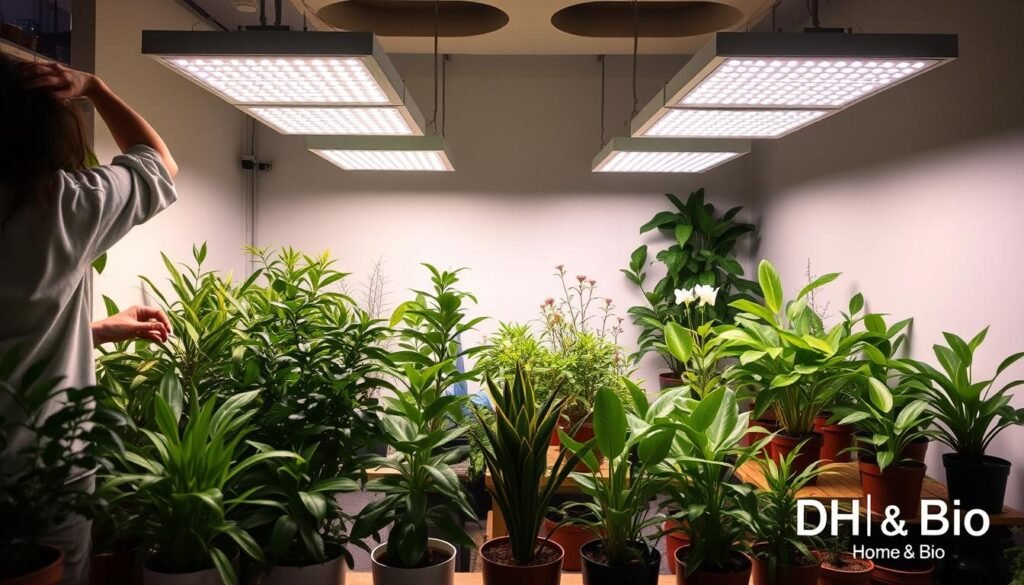
Using artificial lighting for your indoor garden comes with its own set of challenges. Two major mistakes to watch out for are #luzesparaestufaseverdejardinagem and placing lights incorrectly.
Overexposure to Light
Many gardeners make the mistake of giving their plants too much artificial light. Light stress happens when plants get too much light. This can cause stunted growth, color changes, and even damage to the plants. It’s key to keep an eye on your plants and make sure they get the right amount of light.
Incorrect Light Placement
Getting the right #luzesparaestufaseverdejardinagem is vital for your plants’ health. If the lights are too close, it can cause heat stress and scorch the leaves. On the other hand, if they’re too far, the plants might not get enough light for photosynthesis.
To fix these problems, take the time to understand your plants’ needs. Adjust the light placement accordingly. By avoiding these common mistakes, you can help your indoor garden grow well with artificial lighting.
| Mistake | Consequence | Solution |
|---|---|---|
| #luzesparaestufaseverdejardinagem | Light stress, stunted growth, discoloration | Monitor light duration and intensity, adjust as needed |
| Incorrect light placement | Heat stress, leaf scorching, insufficient light intensity | Carefully position lights based on plant requirements |
“Achieving the right balance of artificial lighting is essential for the success of your indoor garden. Pay close attention to your plants’ signals and make adjustments accordingly.”
Maintenance Tips for Artificial Lighting
Keeping your #iluminaçaoartificialparaplantas system in good shape is key. It helps your grow lights last longer and work better. Just a few easy steps can keep your lights shining bright.
Cleaning Your Grow Lights
Cleaning your grow lights often is a must. Dust and dirt can block light, hurting your plants. Here’s how to clean them:
- Unplug the lights and let them cool down before cleaning.
- Use a soft, dry cloth to wipe off dust and dirt from the lights and bulbs.
- Don’t use water or strong cleaners, as they can harm your lights.
Replacing Bulbs: When and Why
Grow light bulbs lose strength over time. Replacing them when needed ensures your plants get enough light. Here’s when to do it:
- Watch for a drop in light brightness or coverage. It’s time for new bulbs then.
- Look at the bulb’s lifespan, usually 10,000 to 50,000 hours.
- Change bulbs every 12-24 months, depending on how much you use them.
By following these tips, your #iluminaçaoartificialparaplantas system will stay efficient. Your plants will get the light they need for healthy growth.
The Role of Color Temperature
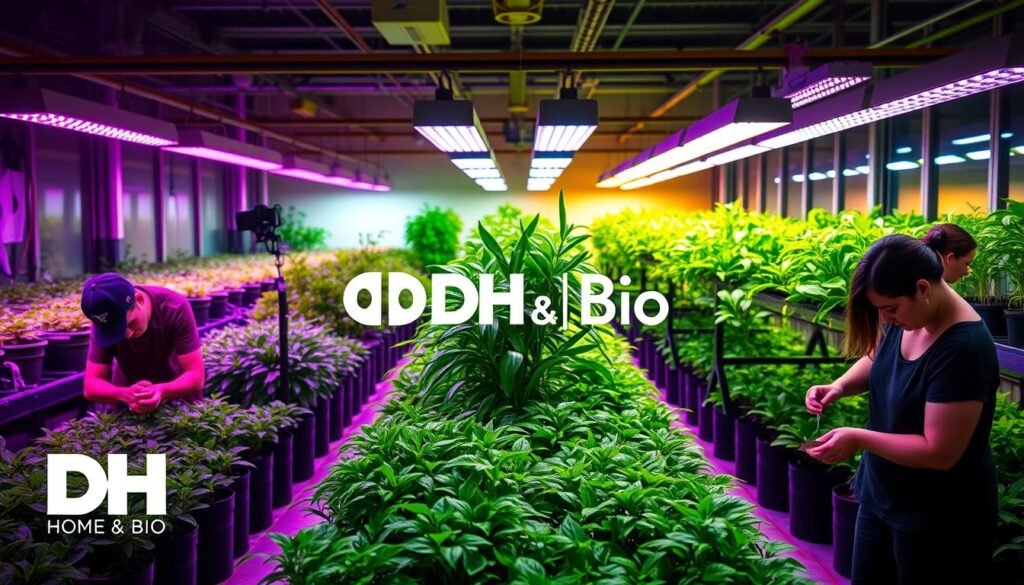
Color temperature is key when choosing #luzesledsparaplantas. It affects how your plants grow and develop. Knowing about Kelvin ratings helps you pick the right light for each stage of plant life.
Understanding Kelvin Ratings
The Kelvin (K) scale measures light color. It ranges from warm, yellowish light (2,700K-3,000K) to cool, blueish light (5,000K-6,500K). Your grow lights’ Kelvin rating greatly impacts plant growth.
Impact of Color on Plant Growth
- Warm colors (2,700K-3,000K) help plants bloom and grow fruit, great for the blooming stage.
- Cooler colors (5,000K-6,500K) boost leaf and stem growth, ideal for seedlings and vegetative stages.
- Combining warm and cool light mimics natural sunlight, offering a balanced spectrum for all growth stages.
Knowing about color temperature and Kelvin ratings is vital for picking the best #luzesledsparaplantas. By matching light spectrum to plant needs, you can enhance plant development and ensure health.
Creating a Light Schedule
Keeping a steady light schedule is key for your indoor plants to grow well. The time and when you give them light affects photosynthesis and flowering. Luckily, there are tools and methods to automate and improve your #iluminaçãointernaparacultivos, making it easier for your plants to thrive.
Importance of Consistent Timing
Plants have a natural light and dark cycle, or “circadian rhythm.” Messing with this can harm their growth and flowering. Giving your plants a steady light schedule helps them grow as they would in nature.
Tools for Automating Light Schedules
Automating your plants’ lighting can be a big help, especially if you’re busy or have many grow spaces. Light timers and automated grow systems let you control light time and timing. This ensures your plants get the right amount of #iluminaçãointernaparacultivos. These tools can be set to turn lights on and off automatically, making sure your plants get consistent light.
Using #iluminaçãointernaparacultivos and the right tools can make your indoor garden flourish with little effort. A good light schedule is the base for success in your #iluminaçãointernaparacultivos journey.
Understanding Grow Light Labels and Specifications

Indoor gardening depends a lot on the quality of your grow lights. It can be hard to understand all the specifications, but knowing the basics is key. We’ll look at lumens, watts, and PAR to help you pick the best #lâmpadasdeledparavegetação for your plants.
Decoding Lumens and Watts
Lumens and watts are used to describe grow light output and energy use. Lumens show the total visible light, while watts show the power used. But, more watts doesn’t always mean better plant growth. The light’s efficiency and spectrum are more important.
What You Need to Know About PAR
PAR, or Photosynthetically Active Radiation, is key for grow light choice. It measures light wavelengths important for photosynthesis, from 400 to 700 nanometers. Look for the PAR value when picking a grow light. A higher PAR means more light for plant growth.
| Specification | Explanation | Importance for Plant Growth |
|---|---|---|
| Lumens | Total amount of visible light emitted | Provides an overall measurement of light output, but doesn’t directly indicate the suitability for plant growth |
| Watts | Electrical power consumed | Higher wattage doesn’t always mean better plant growth; efficiency and light spectrum are more important |
| PAR | Wavelengths of light essential for photosynthesis (400-700 nm) | The most relevant metric for evaluating the effectiveness of a grow light for plant growth and development |
Knowing these specifications helps you choose the right #lâmpadasdeledparavegetação for your indoor garden. This ensures your plants get the best light for growth.
Budget-Friendly Options for Grow Lights
Growing plants indoors doesn’t have to cost a lot. There are many affordable ways to light up your plants. You can make your own or buy a pre-made system. This way, your indoor garden can thrive without spending too much.
DIY Solutions
DIY grow lights are great for saving money and being creative. You can make your own light system with simple materials. Think about using desk lamps, clamp lights, or old fixtures with LED bulbs. It’s fun to make your own #DIYgrowlights.
Affordable Brands to Consider
- Jardins de Janela: This brand offers affordable #fontesdeluzsuplementaresparaplantas for small gardens. Their lights are energy-efficient and easy to set up.
- DH Home & Bio: They focus on cheap lighting solutions. Their #fontesdeluzsuplementaresparaplantas help plants grow without costing a lot.
- Blog dhhomebio.com: DH Home & Bio also has a blog. It’s full of tips on picking the best #fontesdeluzsuplementaresparaplantas for your garden.
When choosing #iluminaçaoartificialparaplantas, look for a good balance of price and quality. These affordable options let you enjoy #fontesdeluzsuplementaresparaplantas without spending a lot. Happy gardening!
Real-Life Success Stories with #iluminaçaoartificialparaplantas
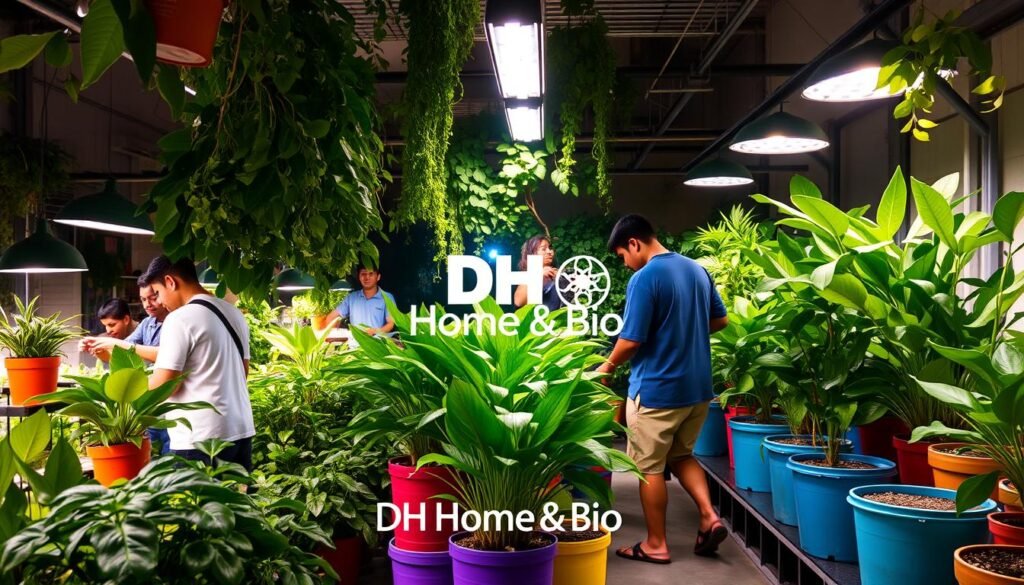
Looking for inspiration for your indoor garden? Check out the success stories of growers who use artificial light. They’ve grown everything from veggies to houseplants, showing how artificial light can make plants thrive indoors.
Jardins de Janela is a small urban homestead in a busy city. They had little outdoor space, so they used artificial light to create a vibrant indoor garden. With LED grow lights and smart light placement, they grow fruits and veggies all year.
DH Home & Bio is a blog about indoor gardening. The team uses artificial light to grow a wide variety of houseplants. They’ve even grown rare and exotic plants that love tropical climates.
These stories prove that artificial light can make indoor gardening a success. Whether you want to grow your own food or create a beautiful indoor space, these examples will inspire you. They show how to master growing plants with artificial light.
“Using artificial lighting has been a game-changer for my indoor garden. I now have the ability to grow a wide variety of plants, regardless of the natural light conditions in my home.”
| Grower | Project | Key Achievements |
|---|---|---|
| Jardins de Janela | Urban Indoor Vegetable Garden | Harvested a variety of fruits and vegetables, including tomatoes, leafy greens, and herbs, using LED grow lights. |
| DH Home & Bio | Thriving Houseplant Collection | Cultivated a diverse range of lush houseplants, including rare and exotic species, through the use of artificial lighting. |
Integrating Artificial Lighting with Natural Light
Indoor gardening needs the right mix of #tecnologiadefotoperíodoartificial and natural light for plants to thrive. Combining these light sources creates a perfect growing space. This mix maximizes the benefits of both.
Using #supplemental lighting can enhance natural light in your space. Place grow lights near windows or skylights for extra light. Adjust the light’s duration and intensity to meet your plants’ needs.
Greenhouses are a great example of this approach. Natural sunlight and artificial lighting work together. This combo extends the growing season and boosts plant growth, even in poor natural light.
For window gardens, #supplemental lighting is crucial. It fills gaps where natural light is scarce. By placing grow lights wisely, you blend natural and artificial light. This ensures your plants flourish.
Success depends on knowing your plants’ needs and adjusting your lighting. The right mix of #tecnologiadefotoperíodoartificial and natural light unlocks your garden’s potential. Enjoy a bountiful harvest all year.
| Lighting Approach | Advantages | Considerations |
|---|---|---|
| Supplemental Artificial Lighting |
|
|
| Integrated Natural and Artificial Lighting |
|
|
Mastering the blend of #tecnologiadefotoperíodoartificial and natural light unlocks your garden’s potential. Enjoy the rewards of successful plant cultivation.
Future Trends in Artificial Plant Lighting
The world of indoor gardening and urban horticulture is changing fast. Artificial plant lighting is set to make a big leap forward. LED technology is getting better, making lights more efficient, versatile, and affordable. This is great news for both hobbyists and commercial growers.
Smart grow lights are also on the rise. These systems use advanced sensors, automated controls, and even AI. They adjust light intensity, spectrum, and duration for better plant growth and energy savings.
Artificial lighting is now connecting with smart home tech. Soon, you’ll control your garden’s lighting, temperature, and water from your phone. This makes gardening easier and more efficient than ever.
The need for fresh, local produce is growing. Artificial plant lighting will be key in indoor and urban agriculture’s future. With LED advancements and smart grow lights, perfect growing conditions are just a tap away.
At Jardins de Janela, we’re watching these trends closely. Our team is committed to sharing the latest in #luzesparaestufaseverdejardinagem. Stay updated with us at dhhomebio.com and @dhhomebio on Instagram.
Conclusion: Embracing #iluminaçaoartificialparaplantas for Successful Indoor Gardening
This guide has shown how #iluminaçaoartificialparaplantas changes indoor gardening. You now know about light spectrums and artificial grow lights. This knowledge helps you grow plants indoors, even with little space.
Usar #iluminaçaoartificialparaplantas permite que suas plantas recebam a luz certa para crescer bem. É ótimo tanto para jardineiros novos quanto experientes. Essa tecnologia pode fazer suas plantas de interior parecerem incríveis.
No Jardins de Janela, ajudamos jardineiros de interior a cultivar plantas com sucesso. Nosso blog em dhhomebio.com e as mídias sociais no Instagram (@dhhomebio) e YouTube (dhhomebio.com) compartilham dicas e histórias de sucesso. Junte-se a nós para explorar a beleza das plantas de interior com #iluminaçaoartificialparaplantas.
